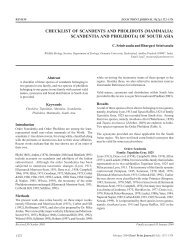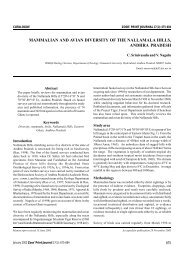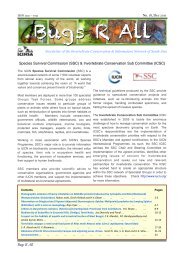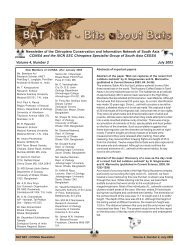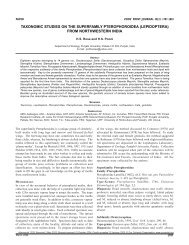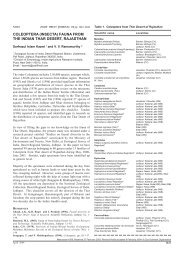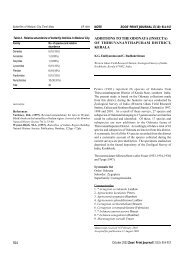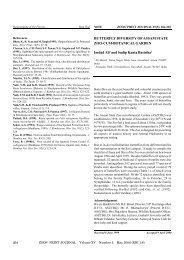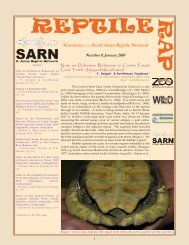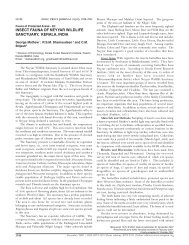Srinu's insectivores 10Jan04 final - zoo's print
Srinu's insectivores 10Jan04 final - zoo's print
Srinu's insectivores 10Jan04 final - zoo's print
- No tags were found...
You also want an ePaper? Increase the reach of your titles
YUMPU automatically turns print PDFs into web optimized ePapers that Google loves.
REVIEW ZOOS' PRINT JOURNAL 19(2): 1361-1371CHECKLIST OF INSECTIVORES (MAMMALIA: INSECTIVORA)OF SOUTH ASIAS. Chakraborty 1 , C. Srinivasulu 2 *, Bhargavi Srinivasulu 2 , M.S. Pradhan 3 and P.O. Nameer 41Zoological Survey of India, ‘M’ Block, New Alipur, Kolkata, West Bengal 700053, India.2Wildlife Biology Section, Department of Zoology, Osmania University, Hyderabad, Andhra Pradesh 500007, India.3Western Regional Station, Zoological Survey of India, Vidyanagar, Sector 29, Rawat Road, PCNTDA Post, Pune, Maharashtra 411044, India.4Department of Wildlife, College of Forestry, Kerala Agricultural University, Velanikkara, Thrissur, Kerala 680656, India.* Corresponding authorEmail: 1 anindita3000@yahoo.co.in; 2 hyd2_masawa@sancharnet.in; 3 zsipune@mah.nic.in; 4 trc_nameer@sancharnet.inAbstractA checklist of 38 species of <strong>insectivores</strong> belonging to12 genera under four subfamilies in three families,(namely, Erinaceidae Fischer, 1817; Talpidae Fischer, 1817and Soricidae Fischer, 1817) known to occur in SouthAsia including Bangladesh, Bhutan, India, Nepal,Pakistan and Sri Lanka is provided.KeywordsChecklist, Erinaceidae, Soricidae, Talpidae,Insectivora, Mammalia, South AsiaIntroductionUnlike Order Rodentia on which comprehensive works byEllerman (1940, 1961) exist, the Order Insectivora has not beengiven much attention. Details of species diversity of the OrderInsectivora is available in Blyth (1863), Jerdon (1874), Sterndale(1884), Blanford (1888), Lindsay (1929), Ellerman and Morrison-Scott (1951), and, Corbet and Hill (1992). Very recently IUCN(1995) has put together a comprehensive list of known<strong>insectivores</strong> of Eurasia. As is applicable to all other groups, theOrder Insectivora too has witnessed numerous taxonomicchanges since the aforementioned literature became available.Keeping this in view, an attempt has been made, here, to recordan updated checklist of the insectivore species reported fromthis region. The checklist also provides information on theirsynonyms, subspecies and distribution.MethodsThe present work relies on Corbet and Hill (1992), Hutterer(1993), IUCN (1995) and a list prepared by Dr. Mike Jordan. Wereviewed the major works by Ellerman and Morrison-Scott (1951,1953), Phillips (1980), Corbet and Hill (1991, 1992), Hutterer (1993),IUCN (1995), and, Roberts (1997) to gain insights on the currenttaxonomic status of <strong>insectivores</strong> occurring in the region.Besides these, we also referred to numerous sources forinformation including Sclater (1891), Cabrera (1925), Lindsay(1929), Allen (1938), Ellerman and Morrison-Scott (1951),Harrison (1958), Petter (1963), Biswas and Ghose (1970), Abe(1971, 1932), Niethammer (1973), Chakraborty (1975, 1983),Doglov and Hoffman (1977), Jameson and Jones (1977), Mitchell(1975), Corbet (1978, 1988), Hutterer (1979), Corbet and Hill (1980,1986), Saha (1980), Hoffman (1986, 1987), Butler (1988), George(1988), Yates and Moore (1990), Abe et al. (1991), Frost et al.(1991), Agrawal (1993), Pradhan, et al. (1997), Nameer (1999),Nowak (1999), and Alfred et al. (2002).This paper follows Srinivasulu and Pradhan (2003) for scientificnames, synonyms and distribution information in South Asia.ResultsA total of 38 species of <strong>insectivores</strong> belonging to 12 generaunder four subfamilies of three families have been recordedfrom South Asia. The family Erinaceidae Fischer, 1817 isrepresented by five species belonging to one genus, namelyHemiechinus Fitzinger, 1866. The family Talpidae Fischer, 1817includes two species in two genera, and the family SoricidaeFischer, 1817 includes 31 species in two subfamilies, namely –Soricinae Fischer, 1817 and Crocidurinae Milne-Edwards, 1872.The former subfamily includes 11 species in five genera, whilethe latter includes 20 species in four genera (Table 1).Of this diversity, 15 species (39%) are endemic to South Asiawith four species being endemic to more than one country. Ofthe seven species endemic to India four are restricted toAndaman and Nicobar Islands, while four are endemic to SriLanka (Table 2). Generically the genus Feroculus Kelaart, 1850is endemic to South Asia, and the genus Solisorex Thomas,Received 28 November 2003 Finally accepted 10 January 2004February 2004 Zoos' Print Journal 19(2): 1361-13711361
Checklist of <strong>insectivores</strong> (Mammalia: Insectivora) of South AsiaS. Chakraborty et al.Table 1. Species diversity of Order Insectivora in South AsiaScientific name No. of species RemarksErinaceidaeErinaceinaeHemiechinus 5 Endemics: 1 regional; 1 IndianTalpidaeTalpinaeEuroscaptor 1Parascaptor 1 MonotypicSoricidaeSoricinaeAnourosorex 1 MonotypicChimmarogale 1Sorex 4Soriculus 4Nectogale 1 MonotypicCrocidurinaeCrocidura 11 Endemic: 5 Indian; 1 Sri LankanSolisorex 1 Monotypic, Sri Lankan endemicSuncus 7 Endemic: 2 regional; 1 Indian; 2 SriLankanFeroculus 1 Monotypic, regional endemic1924 is endemic to Sri Lanka.The present known insectivore diversity on record from SouthAsia is listed below. The synonyms provided are thoseapplicable for the South Asian region. We have not listed extralimitalsynonyms that may be valid for some taxa elsewhere.Family: Erinaceidae Fischer, 1817Subfamily: Erinaceinae Fischer, 1817Genus Hemiechinus Fitzinger, 1866HedgehogsCorbet and Hill (1992) treated this genus under subfamilyErinaceinae Fischer, 1817 in family Erinaceidae Fischer, 1817.Originally regarded as a subgenus of Erinaceus Linnaeus, 1758,it was raised to generic status by Corbet (1978, 1988). Frost etal. (1991), IUCN (1995) and Nowak (1999) include two subgenus,namely, Hemiechinus Fitzinger, 1866 and ParaechinusTrouessart, 1879. Ellerman and Morrison-Scott (1951) and Corbetand Hill (1992) treat both these at the generic level. This genusis widespread from northern Africa through China and northernSouth Asia. This genus is represented by five species in twosubgenera in the region.1. Hemiechinus auritus (Gmelin, 1770)1770. Erinaceus auritus Gmelin, Nov. Comm. Acad. Sci. Petrop.,14: 519.Name: Long-eared HedgehogType locality: Astrakhan, Southeastern RussiaSynonyms: Erinaceus auritus Gmelin, 1770Erinaceus megalotis Blyth, 1845Subspecies: Hemiechinus auritus megalotis (Blyth, 1845)Distribution: Baluchistan in Pakistan.Comments: Belongs to subgenus Hemiechinus Fitzinger,1866. Ellerman and Morrison-Scott (1951) treated Hemiechinusmegalotis Blyth, 1845 as a distinct species and included 16subspecies of Hemiechinus auritus (Gmelin, 1770) of whichonly one subspecies, now a species, pertains to South Asia.This was also followed by Roberts (1997). Niethammer (1973)treated Hemiechinus megalotis Blyth, 1845 as a subspecies,followed by Corbet and Hill (1992), Hutterer (1993) and IUCN(1995).Table 2. Insular endemic species of Order Insectivora in South AsiaScientific Name Distribution RemarksCrocidurinaeCrocidura andamanensis Andaman & Nicobar Islands Only from South Andaman IsleCrocidura hispida Andaman & Nicobar Islands Only from Middle Andaman IsleCrocidura jenkinsi Andaman & Nicobar Islands Only from South Andaman IsleCrocidura miyaSri LankaCrocidura nicobarica Andaman & Nicobar Islands Only from Great Nicobar IsleSolisorex pearsoni Sri Lanka Only fron C HighlandsSuncus fellowes-gordoni Sri LankaSuncus zeylanicusSri Lanka1362February 2004 Zoos' Print Journal 19(2): 1361-1371
Checklist of <strong>insectivores</strong> (Mammalia: Insectivora) of South AsiaS. Chakraborty et al.15. Soriculus leucops (Hodgson, 1855)1855. Sorex leucops Hodgson in Horsfield, Ann. Mag. Nat. Hist.,[2]16: 111.Name: Indian Long-tailed ShrewType locality: NepalSynonyms: Sorex leucops Hodgson, 1855Episoriculus leucops (Hodgson, 1855)Sorex nivicola Gray, 1863 (nom. nud.)Sorex minor Dobson, 1890Sorex baileyi Thomas, 1914Soriculus caudatus bailey (Thomas, 1914)Soriculus gruberi Weigel, 1969Subspecies: None.Distribution: Assam, Manipur, Sikkim and West Bengal inIndia; Nepal.Comments: This species belongs to subgenus EpisoriculusEllerman and Morrison-Scott, 1951. Van Valen (1967) andRepenning (1967) treated this taxon as Episoriculus leucops(Hodgson, 1855). Sometimes the names baileyi and gruberiare considered valid species (IUCN, 1995). However, accordingto Corbet and Hill (1992) the forms representing Sorex baileyiThomas, 1914 are confused with Soriculus macrurus Blanford,1888. Hutterer (1993) includes Sorex baileyi as subspecies ofSoriculus leucops (Hodgson, 1855) following Hoffman (1986).16. Soriculus macrurus Blanford, 18881888. Soriculus macrurus Blanford, Fauna Brit. India Mamm. I: 231.Name: Arboreal Brown-toothed ShrewType locality: Darjeeling, West Bengal, IndiaSynonyms: Sorex macrurus Hodgson, 1863 (nom. nud.)Episoriculus macrurus (Blanford, 1888)Subspecies: NoneDistribution: Sikkim in India; Nepal.Comments: This species belongs to subgenus EpisoriculusEllerman and Morrison-Scott, 1951. Ellerman and Morrison-Scott (1951) synonymized it with Soriculus leucops (Hodgson,1855) following Osgood (1932). Van Valen (1967) and Repenning(1967) treated this taxon as Episoriculus macrurus (Blanford,1888). Corbet and Hill (1992), Hutterer (1993), and IUCN (1995)treat it as distinct species following Hoffman (1986).17. Soriculus nigriscens (Gray, 1842)1842. Corsira nigriscens Gray, Ann. Mag. Nat. Hist., [Ser]10: 261.Name: Sikkim Large-clawed ShrewType locality: Darjeeling, West Bengal, IndiaSynonyms: Corsira nigriscens Gray, 1842Sorex aterrimus Blyth, 1842 (nom. nud.)Sorex sikimensis Hodgson, 1849 (nom. nud.)Subspecies: Soriculus nigriscens nigriscens (Gray, 1842)Soriculus nigriscens caurinus Hinton, 1922Soriculus nigriscens pahari Hinton, 1922Soriculus nigriscens centralis Hinton, 1922Distribution: Assam, Sikkim, Uttranchal and West Bengal inIndia; Bhutan; Nepal.Comments: This species belongs to subgenus SoriculusBlyth, 1854. Myanmar specimens belong to Soriculusnigriscens radulus Thomas, 1922.Genus Nectogale Milne-Edwards, 1870Web-footed (or Elegant) Water ShrewThis genus belongs to subfamily Soricinae Fischer, 1817. It ismonospecific genus represented by a species that is restrictedto Oriental region and shows affinity to high altitude mountainstreams (Mitchell, 1975).18. Nectogale elegans (Milne-Edwards, 1870)1870. Nectogale elegans Milne-Edwards, C.R. Acad. Sci. Paris,70: 341.Name: Web-footed/Elegant Water ShrewType locality: Moupin, Sichuan, ChinaSynonyms: Nectogale sikhimensis de Winton and Styan, 1899Subspecies: Nectogale elegans elegans Milne-Edwards, 1870Nectogale elegans sikhimensis de Winton andStyan, 1899Distribution: Sikkim in India; Bhutan; Nepal.Comments: Monospecific, distributed in the Himalaya fromNepal to Sichuan in China. See Hoffman (1987) for commentson status of Nectogale sikhimensis deWinton and Styan, 1899based on which Corbet and Hill (1992), Hutterer (1993) andIUCN (1995) treated it as a distinct subspecies.Subfamily Crocidurinae Milne-Edwards, 1872Genus Crocidura Wagler, 1832White-toothed ShrewsThis genus belongs to subfamily Crocidurinae Milne-Edwards,1872. This genus is widespread ranging from Africa to Europeand South East Asia and includes many forms in foursubgenera. It is represented by 11 species belonging tosubgenus Crocidura Wagler, 1832 in the region.19. Crocidura andamanensis Miller, 19021902. Crocidura andamanensis Miller, Proc. U. S. Natnl. Mus., 24: 777.Name: Andaman White-toothed ShrewType locality: MacPherson Strait, South Andaman Isle,Andaman and Nicobar Islands, IndiaSynonyms: None.Subspecies: None.Distribution: Endemic to India, known only from type locality.Comments: According to Ellerman and Morrison-Scott(1951) this taxon is probably closely allied to Crociduranicobarica Miller, 1902.20. Crocidura attenuata Milne-Edwards, 18721872. Crocidura attenuata Milne-Edwards, Rech. Hist. Nat.Mamm., pp. 263.Name: Grey Shrew1366February 2004 Zoos' Print Journal 19(2): 1361-1371
Checklist of <strong>insectivores</strong> (Mammalia: Insectivora) of South AsiaS. Chakraborty et al.Type locality: Moupin, Sichuan Province, ChinaSynonyms: Crocidura rubricosa Anderson, 1877Crocidura attenuata rubricosa Anderson, 1877Crocidura kingiana Anderson, 1877Crocidura attenuata kingiana Anderson, 1877Subspecies: None.Distribution: Assam, Jammu and Kashmir, Sikkim andUttaranachal, in India; Nepal; Bhutan.Comments: Ellerman and Morrison-Scott (1951) includedfour subspecies under this taxon. However, Corbet and Hill(1992), Hutterer (1993) and IUCN (1995) maintain that there areno subspecies of this taxon.21. Crocidura gueldenstaedtii (Pallas, 1811)1811. Sorex güldenstaedtii Pallas, Zoogr. Ross. Asiat., I: 132. pl.9, fig. 1.Name: Gueldenstaedt’s White-toothed ShrewType locality: Near Dushet, GeorgiaSynonyms: Sorex güldenstaedtii Pallas, 1811Crocidura russula güldenstaedtii (Pallas, 1811)Crocidura pullata Miller, 1911Crocidura russula pullata (Miller, 1911)Subspecies: None.Distribution: Jammu and Kashmir, and Pakistan-occupied-Kashmir in India; North West Frontier Province in Pakistan.Comments: Ellerman and Morrison-Scott (1951) and Jenkins(1976) included Crocidura gueldenstaedtii Pallas, 1811 andCrocidura pullata Miller, 1911 as subspecies of Crocidurarussula Hermann, 1780. These have been treated as distinctspecies by Corbet and Hill (1992), Hutterer (1993), and IUCN(1995). Furthermore, Hutterer (1993) reffering to Catzeflis et al.(1985) opines that Crocidura güeldenstaedtii Pallas, 1811,Crocidura pullata Miller, 1911 and Crocidura russula Hermann,1780 could be conspecific with Crocidura suaveolens Pallas,1811.22. Crocidura hispida Thomas, 19131913. Crocidura hispida Thomas, Ann. Mag. Nat. Hist., [8]11: 468.Name: Andaman ShrewType locality: North End, Middle Andaman Isle, Andaman andNicobar Islands, IndiaSynonyms: None.Subspecies: None.Distribution: Endemic to India, known only from AndamanIsles, Andaman and Nicobar Islands.Comments: None.23. Crocidura horsfieldi (Tomes, 1856)1856. Sorex horsfieldi Tomes, Ann. Mag. Nat. Hist., [2]17: 23.Name: Horsfield’s ShrewType locality: Sri LankaSynonyms: Sorex horsfieldi Tomes, 1856Crocidura retusa Peters, 1870Sorex (Crocidura) myoides Blanford, 1875Subspecies: Crocidura horsfeildi horsfieldi (Tomes, 1856)Crocidura horsfieldi myoides (Blanford, 1875)Distribution: Jammu and Kashmir in India; Nepal; Sri Lanka.Comments: Refer Jenkins (1976) and Jameson and Jones(1977) for further details. Variations between insular (Sri Lankan)and Himalayan forms require further taxonomic studies.24. Crocidura jenkinsi Chakraborty, 19781978. Crocidura jenkinsi Chakraborty, Bull. Zool. Surv. India, 1: 303.Name: Jenkin’s Andaman Spiny ShrewType locality: Wright Myo, South Andaman Isle, Andamanand Nicobar Islands, IndiaSynonyms: None.Subspecies: None.Distribution: Endemic to India, known only from type localityand Mount Harriet.Comments: None.25. Crocidura leucodon (Hermann, 1780)1780. Sorex leucodon Hermann in Zimmerman, Geogr. Gesch.Mensch. Vierf. Thiere, 2: 382.Name: Bicoloured White-toothed ShrewType locality: Bashkin, Strasburg, FranceSynonyms: Sorex leucodon Hermann, 1780Subspecies: None for the region.Distribution: Jammu and Kashmir, and Pakistan-occupied-Kashmir in India; probably also in Pakistan.Comments: Chakraborty (1983) reports its occurrence inIndia based on a male specimen collected in 1974 from Daksum,Jammu and Kashmir.26. Crocidura miya Phillips, 19291929. Crocidura miya Phillips, Spolia Zeylan., 15: 113.Name: Sri Lankan Long-tailed ShrewType locality: Moolgama, Kandiyan Hills, Nilambe dt., SriLankaSynonyms: None.Subspecies: None.Distribution: Endemic to Sri Lanka.Comments: Refer Phillips (1980) for further details.27. Crocidura nicobarica Miller, 19021902. Crocidura nicobarica Miller, Proc. U. S. Natnl. Mus., 24: 776.Name: Nicobar ShrewType locality: Greater Nicobar Isle, Andaman and NicobarIslands, IndiaSynonyms: None.Subspecies: None.Distribution: Endemic to India, known only from type locality.Comments: None.February 2004 Zoos' Print Journal 19(2): 1361-13711367
Checklist of <strong>insectivores</strong> (Mammalia: Insectivora) of South AsiaS. Chakraborty et al.28. Crocidura pergrisea Miller, 19131913. Crocidura pergrisea Miller, Proc. Biol. Soc. Washington, 26: 113.Name: Pale Grey ShrewType locality: Skoro Loomba, Shigar, Baltistan, Jammu andKashmir, IndiaSynonyms: None.Subspecies: None.Distribution: Endemic to India, known only from type localityin Pakistan-occupied-Kashmir.Comments: Ellerman and Morrison-Scott (1951) includedzarudnyi Ognev, 1928 as subspecies of this taxon. Hassinger(1973) treated zarudnyi Ognev, 1928 as a distinct species, atrend that was followed by Corbet and Hill (1992), Hutterer(1993) and IUCN (1995).29. Crocidura zarudnyi Ognev, 19281928. Crocidura zarudnyi Ognev, Mamm. E. Europe, N. Asia, I: 341.Name: Zarudny’s ShrewType locality: Near Baluchistan border, eastern Iran.Synonyms: Crocidura pergrisea zarudnyi Ognev, 1928.Subspecies: None.Distribution: Baluchistan in Pakistan.Comments: Earlier named as Crocidura tatianae Ognev,1921, the name that was preoccupied by Crocidura nyansaetatianae Dollman, 1915 a taxon from Africa. Thus, the currentname Crocidura zarudnyi Ognev, 1928 is valid.Genus Solisorex Thomas, 1924Sri Lankan Long-clawed ShrewThis monospecific Sri Lankan endemic genus belongs tosubfamily Crocidurinae Milne-Edwards, 1872.30. Solisorex pearsoni Thomas, 19241924. Solisorex pearosni Thomas, Spolia Zeylan., 13: 94.Name: Pearson’s Long-clawed ShrewType locality: Hakgala, Nuwara Eliya, Central Highlands, SriLankaSynonyms: None.Subspecies: None.Distribution: Endemic to Central Highlands of Sri Lanka.Comments: None.Genus Suncus Erhenberg, 1833Musk ShrewsThis genus belongs to subfamily Crocidurinae Milne-Edwards,1872. Ellerman and Morrison-Scott (1951) and Harrison andBates (1991) suggested that this genus was not more than asubgenus of Crocidura Wagler, 1832. It is represented by sevenspecies in the region.31. Suncus dayi (Dobson, 1888)1888. Crocidura dayi Dobson, Ann. Mag. Nat. Hist., [6]1: 428.Name: Day’s ShrewType locality: Trichur (now Thrissur), Cochin (now Kochi) inKerala, IndiaSynonyms: Crocidura dayi Dobson, 1888Subspecies: None for the regionDistribution: Endemic to India, known only from a fewlocalities in southern IndiaComments: None.32. Suncus etruscus (Savi, 1822)1822. Sorex etruscus Savi, Nuovo Giorn. De Litterati, Pisa, 1: 60.Name: Savi’s Pygmy ShrewType locality: Pisa, ItalySynonyms: Sorex etruscus Savi, 1822Sorex perrotteti Duvernoy, 1842Sorex micronyx Blyth, 1855Sorex hodgsoni Blyth, 1855Sorex atratus Blyth, 1855Ssorex nudipes Blyth, 1855Pachyura assamensis Anderson, 1873Crocidura (Pachyura) nilagirica Anderson, 1877Crocidura (Pachyura) pygmaeoides Anderson,1877Crocidura (Pachyura) travancorensisAnderson, 1877Crocidura (Pachyura) nitidofulva Anderson,1877Subspecies: Suncus etruscus perrotteti (Duvernoy, 1842)Suncus etruscus nudipes (Blyth, 1855)Suncus etruscus micronyx (Blyth, 1855)Suncus etruscus pygmaeoides (Anderson, 1877)Suncus etruscus nitidofulva (Anderson, 1877)Distribution: Andhra Pradesh, Assam, Bihar, Chattisgarh,Gujarat, Harayana, Himachal Pradesh, Jharkhand, Karnataka,Kerala, Maharashtra, Manipur, Orissa, Pondicherry, Punjab,Rajasthan, Sikkim, Tamil Nadu, Uttaranchal, Uttar Pradesh andWest Bengal in India; Nepal; Bhutan; Pakistan; Sri Lanka.Comments: Ellerman and Morrison-Scott (1951) listedSuncus fellowes-gordoni Phillips, 1932 under this taxon as asubspecies, while Corbet and Hill (1991, 1992) synonymized itwith this taxon. However, Hutterer (1993) and IUCN (1995)treated it as distinct species. Eisenberg and McKay (1970) didnot treat Podihik kura Deraniyagala, 1958 being distinct fromSuncus etruscus (Savi, 1822), as followed by Hutterer (1993).33. Suncus fellowes-gordoni Phillips, 19321932. Suncus fellowes-gordoni Phillips, Spolia Zeylan., 17: 124.Name: Ceylon Pygmy ShrewType locality: West Haputale Estate, Ohiya, C Province, Sri LankaSynonyms: Suncus fellowes-gordoni Phillips, 1932Podihik kura Deraniyagala, 1958Subspecies: None.Distribution: Endemic to Sri LankaComments: Ellerman and Morrison-Scott (1951) treated this1368February 2004 Zoos' Print Journal 19(2): 1361-1371
Checklist of <strong>insectivores</strong> (Mammalia: Insectivora) of South AsiaS. Chakraborty et al.taxon as a subspecies of Suncus etruscus (Savi, 1822). Corbet(1978) and Corbet and Hill (1991, 1992) synonymized Suncusfellowes-gordoni Phillips, 1932 and Podihik kura Deraniyagala,1958 with Suncus etruscus (Savi, 1832). Hutterer (1993) opinesthat the Podihik kura is more similar to Suncus etruscus (Savi,1822) than to Suncus fellowes-gordoni Phillips, 1932. Hutterer(1993) and IUCN (1995) treated Suncus fellowes-gordoni Phillips,1932 as a distinct species.34. Suncus montanus (Kelaart, 1850)1850. Sorex montanus Kelaart, J. Ceylon Branch Asiat. Soc., 2: 211.Name: Hill ShrewType locality: Pidurutalagala, Nuwara Eliya, Sri LankaSynonyms: Sorex montanus Kelaart, 1850Suncus murinus montanus (Kelaart, 1850)Sorex feruginea Kelaart, 1850Sorex ferugeneus Kelaart, 1850? Sorex niger Horsfield, 1851Suncus niger malabaricus Lindsay, 1929Subspecies: None.Distribution: Endemic to the region. Karnataka, Kerala andTamil Nadu in India; Sri Lanka.Comments: Lindsay (1929) described darker forms akin tothis species from southern India as Suncus niger malabaricusthat has been considered as possible subspecies of the Suncusmurinus (Linnaeus, 1766) by Ellerman and Morrison-Scott(1951). However, Corbet (1992) proposed it to be a validsubspecies of Suncus montanus (Kelaart, 1850) and acceptedby Corbet and Hill, 1992, Hutterer, 1993 and IUCN, 1995.35. Suncus murinus (Linnaeus, 1766)1766. Sorex murinus Linnaeus, Syst. Nat. 12 th ed., I: 74.Name: House ShrewType locality: Java, IndonesiaSynonyms: Sorex murinus Linnaeus, 1766Sorex indicus Geoffroy, I., 1811Sorex sonerratii Geoffroy, I., 1827Sorex giganteus Geoffroy, I., 1831Sorex serpentarius Geoffroy, I., 1831Sorex nemorivagus Hodgson, 1845Sorex soccatus Hodgson, 1845Suncus murinus soccatus (Hodgson, 1845)Sorex griffithi Horsfield, 1851Suncus murinus griffithi (Horsfiled, 1851)Sorex kandianus Kelaart, 1852Suncus murinus kandianus (Kelaart, 1852)Sorex heterodon Blyth, 1855Sorex kelaarti Blyth, 1855Sorex saturatior Hodgson, 1855Suncus murinus saturatior (Hodgson, 1855)Sorex viridiscens Blyth, 1859Sorex tytleri Blyth, 1859Suncus murinus tytleri (Blyth, 1859)Crocidura (Pachyura) waldemarii Peters, 1870Crocidura (Pachyura) ceylanica Peters, 1870Crocidura (Pachyura) media Peters, 1870Crocidura (Pachyura) fulvocinerea Anderson, 1877Suncus murinus fulvocinereus (Anderson, 1877)Crocidura (Pachyura) blythii Anderson, 1877Crocidura (Pachyura) sindensis Anderson, 1877Crocidura (Pachyura) pealana Anderson, 1877Crocidura (Pachyura) blanfordii Anderson, 1877Suncus murinus blanfordii (Anderson, 1877)Crocidura (Pachyura) rubicunda Anderson, 1877Crocidura andersoni Trouessart, 1879Crocidura beddomei Anderson, 1881Sorex beddomei (Anderson, 1881)Subspecies: Suncus murinus murinus (Linnaeus, 1766)Suncus murinus caerulescens Shaw, 1800Suncus murinus sindensis Anderson, 1877Suncus murinus nemorivagus Hodgson, 1845Suncus murinus viridescens Blyth, 1859Distribution: Andhra Pradesh, Assam, Bihar, Chattisgarh,Gujarat, Harayan, Himachal Pradesh, Jharkhand, Karnataka,Kerala, Maharashtra, Manipur, Meghalaya, Mizoram, Orissa,Pondicherry, Punjab, Rajasthan, Sikkim, Tamil Nadu, Tripura,Uttaranchal, Uttar Pradesh and West Bengal in India; Pakistan;Bangladesh; Nepal; probably in Bhutan.Comments: Ellerman and Morrison-Scott (1951) listed morethan 15 subspecies under this taxon, including Sri Lankan formsSuncus montanus Kelaart, 1850 and Suncus zeylanicus Phillips,1928 which are now treated as distinct species (Phillips, 1980;Corbet & Hill, 1992; Hutterer, 1993). Phillips (1980) treated Sorexmurinus kandianus (Kelaart, 1852) as a valid subspecies fromSri Lanka. This species has been synonymized withSuncus murinus (Linnaeus, 1766) by Corbet and Hill (1992).According to Corbet and Hill (1992) Suncus murinusnemorivagus Hodgson, 1845 possibly includes Suncus murinussoccatus (Hodgson, 1845), Suncus murinus griffithi (Horsfield,1851), Suncus murinus saturatior (Hodgson, 1855) and Suncusmurinus tytleri (Blyth, 1859); and Suncus murinusviridescens Blyth, 1859 possibly includes Crocidura(Pachyura) blanfordii Anderson, 1877.36. Suncus stoliczkanus (Anderson, 1877)1877. Crocidura (Pachuyra) stoliczkanus Anderson, J. Asiat.Soc. Bengal, 46: 270.Name: Anderson’s ShrewType locality: Bombay, Maharashtra, IndiaSynonyms: Crocidura (Pachuyra) stoliczkanus Anderson, 1877Crocidura (Pachuyra) subfulva Anderson, 1877Crocidura (Pachuyra) bidiana Anderson, 1877Crocidura leucogenys Dobson, 1888Suncus stoliczkanus leucogenys (Dobson, 1888)Subspecies: None for the regionDistribution: Endemic to the region. Gujarat, MadhyaFebruary 2004 Zoos' Print Journal 19(2): 1361-13711369
Checklist of <strong>insectivores</strong> (Mammalia: Insectivora) of South AsiaS. Chakraborty et al.Pradesh, Maharashtra, Uttar Pradesh, Rajasthan and Tamil Naduin India; Pakistan.Comments: Ellerman and Morrison-Scott (1951) listed threesubspeceis under this taxon, that were synonymized by Corbetand Hill (1992), and Hutterer (1993).37. Suncus zeylanicus Phillips, 19281928. Suncus zeylanicus Phillips, Spolia Zeylan., 14: 313.Name: Ceylon Jungle Shrew, Sri Lankan ShrewType locality: Gonagama Estate, Kitulgala, Sri LankaSynonyms: Suncus murinus zeylanicus Phillips, 1928Subspecies: None.Distribution: Endemic to Sri Lanka.Comments: Ellerman and Morrison-Scott (1951) included itunder Suncus murinus (Linnaeus, 1766), but it as been treatedas distinct species basing on major morphological differencesby Phillips ( 1980) and McKay (1984), a trend followed by Corbetand Hill (1992), Hutterer (1993), and IUCN (1995).Genus Feroculus Kelaart, 1850Long-clawed ShrewThis genus belongs to subfamily Crocidurinae Milne-Edwards,1872. It is represented by an endemic species in the region.38. Feroculus feroculus (Kelaart, 1850)1850. Sorex feroculus Kelaart, J. Ceylon Branch Asiat. Soc., 2(5): 211.Name: Kelaart’s Long-clawed ShrewType locality: Central Mountains at ca.828m, Nuwara Eliya,Sri LankaSynonyms: Sorex feroculus Kelaart, 1850Sorex macropus Blyth, 1851Sorex nuwara-ellia Kelaart, 1851Sorex newara Wagner, 1855Crocidura macropus Blyth, 1888Subspecies: None for the region.Distribution: Endemic to South Asia. Kerala and Tamil Naduin India; Sri LankaComments: For details refer Phillips (1980). Corbet and Hill(1992) indicated that there is an old unconfirmed report of thistaxon from Palni Hills, Tamil Nadu in India. However, Pradhanet al. (1997) have confirmed its occurrence and distribution insouthern India.AcknowledgementsWe thank Dr. J.R.B. Alfred, Director, Zoological Survey of India,Kolkatta and Officer-in-Charge, Zoological Survey of India,Western Regional Station, Pune for facilities; Ms. Sally Walkerand Mr. Sanjay Molur, Zoo Outreach Organization, Coimbatorehelped us in many ways; Dr. Mike J.R. Jordan, Chester Zoo,England helped us with initial list. MSP wishes to thank Mr.S.S. Talmale from ZSI, WRS, Pune, for his help. CS and BSthank Dr. V. Nagulu and the Head, Department of Zoology,Osmania University, Hyderabad for encouragement; Ms. BinuPriya and Ms. Padma Priya, Zoo Outreach Organization, fortheir help in literature survey and preparation of the <strong>final</strong>checklist; and also acknowledge the individual Research Grantfrom CSIR, New Delhi.ReferencesAbe, H., S. Shiraishi and S. Arai (1991). A new mole from Uotsurijima,the Ryukyu Islands. Journal of the Mammalogical Society ofJapan 15: 47-60.Abe, H. (1971). Small mammals of Central Nepal. Journal of theFaculty of Agriculture, Hokkaido University, Japan 56: 367-423.Abe, H. (1982). Ecological distribution and faunal structure of smallmammals in central Nepal. Mammalia 46: 477-503.Agrawal, V.C. (1973). A note on the taxonomic status of Erinaceusblanfordi Anderson and Erinaceus jerdoni Anderson (Mammalia:Insectivora). Journal of the Zoological Society of India 25: 158-159.Agrawal, V.C. and S. Chakraborty (1971). Notes on a collection ofsmall mammals from Nepal, with the description of a new mousehare(Lagomorpha: Ochotonidae). Proceedings of the Zoological Societyof Calcutta 24: 41-46.Alfred, J.R.B., N.K. Sinha and S. Chakraborty (2002). Checklistof Mammals of India. Records of the Zoological Survey of India,Occasional Paper 199: 1-289. Zoological Survey of India, Kolkata.Allen, G.M. (1938). The mammals of China and Mongolia. In: Granger,W. (editor). Natural History of Central Asia. Central AsiaticExpeditions of the American Museum of Natural History, New York,11, Part 1: 1-620.Biswas, B. and R.K. Ghose (1970). Taxonomic notes on the Indianpale hedgehogs of the genus Paraechinus Trouessart, with descriptionsof a new species and subspecies. Mammalia 36: 467-477.Blanford, W.T. (1888). The Fauna of British India. Mammalia, Part1. Taylor and Francis, London, 250pp+xii.Blyth, E. (1863). Catalogue of the Mammalia in the Museum of AsiaticSociety. Calcutta. 187+xiii pp.Butler, P.M. (1988). Phylogeny of the Insectivores. pp. 117-141. In:M.J. Benton (editor). The Phylogeny and Classification of theTetrapods, 2 (Mammals). Clarendon Press, Oxford.Cabrera, A. (1925). Genera mammalium: Insectivora, Galaeopithecia.Museo Nacional de Ciencias Naturales, Madrid, 232pp.Catzeflis, F.M., T. Maddalena, S. Hellwing, and P. Vogel (1985).Unexpected findings on the taxonomic status of East MediterraneanCrocidura russula auct. (Mammalia, Insectivora). Zeitschrift fürSäugetierkunde 50: 185-201.Chakraborty, S. (1975). On a collection of mammals from Bhutan.Records of the Zoological Survey of India 68: 1-20.Chakraborty, S. (1983). Contribution to the knowledge of themammalian fauna of Jammu and Kashmir, India. Records of theZoological Survey of India 38: 1-129.Corbet, G.B. (1978). The Mammals of the Palaearctic Region: ATaxonomic Review. British Museum (Natural History), London, 314pp.Corbet, G.B. (1988). The family Erinaceidae: a synthesis of itstaxonomy, phylogeny, ecology and zoogeography. Mammal Review18: 117-172.Corbet, G.B. and J.E. Hill (1980). A World List of MammalianSpecies. British Museum (Natural History), London, 226pp.Corbet, G.B. and J.E. Hill (1986). A World List of MammalianSpecies. Second ed. British Museum (Natural History), London, 254pp.Corbet, G.B. and J.E. Hill (1991). A World List of Mammalian1370February 2004 Zoos' Print Journal 19(2): 1361-1371
Checklist of <strong>insectivores</strong> (Mammalia: Insectivora) of South AsiaS. Chakraborty et al.Species. 3 rd edition. British Museum (Natural History) Publications,London, 243pp.Corbet, G.B. and J.E. Hill (1992). Mammals of the IndomalayanRegion: A Systematic Review. Oxford University Press, Oxford, 488pp.Dolgov, V.A. and R.S. Hoffmann (1977). Tibetskaya burozubka -Sorex thibetanus Kastchenko, 1905 (Soricidae, Mammalia). ZoologicalZhurnal 46: 1687-1692. [In Russian, Original not seen]Eisenberg, J.F. and G.M. McKay (1970). An annotated checklist ofthe recent mammals of Ceylon with keys to the species. Ceylon Journalof Science, Biological Science 8: 69-99.Ellerman, J.R. and T.C.S. Morrison-Scott (1951). Checklist ofPalaearctic and Indian Mammals 1758 to 1946. Trustees of the BritishMuseum (Natural History), London, 810pp.Ellerman, J.R. and T.C.S. Morrison-Scott (1953). Checklist ofPalaearctic and Indian Mammals - amendments. Journal of Mammalogy34: 516-518.Frost, D.R., W.C. Wozencraft and R.S. Hoffmann (1991).Phylogenetic relationships of hedgehogs and gymnures (Mammalia:Insectivora: Erinaceidae). Smithsonian Contributions to Zoology 518.Smithsonian Institution Press, Washington, pp.1-69.George, S.B. (1988). Systematics, historical biogeography andevolution of the genus Sorex. Journal of Mammalogy 69: 443-461.Harrison, J. L. (1958). Chimarrogale hantu a new water shrew fromthe Malay Peninsula, with a note on the genera Chimarrogale andCrossogale (Insectivora, Soricidae). Annals and Magazine of NaturalNistory [13]1: 282-290.Hassinger, J.D. (1973). A survey of the mammals of Afghanistanresulting from the 1965 Street Expedition (excluding bats). FieldianaZoology 60: 1-195.Hoffmann, R.S. (1986). A review of the genus Soriculus (Mammalia:Insectivora). Journal of the Bombay Natural History Society 82: 459-481.Hoffmann, R.S. (1987). A review of the systematics and distributionof Chinese red-toothed shrews (Mammalia: Soricinae). ActaTheriologica Sinica 7: 100-139.Hutterer, R. (1979). Verbreitung und systematik von Sorex minutusLinnaeus, 1766 (Insectivora: Soricidae) im Nepal-Himalaya undangrenzenden gebieten. Zeitschrift für Säugetierkunde 44: 65-80.Hutterer, R. (1993). Order Insectivora, pp. 69-130. In: Wilson, D.E.and D.M. Reeder (editors) Mammal Species of the World: A Taxonomicand Geographic Reference. 2 nd edition, Smithsonian Institution Press,Washington, D.C., 1206pp.IUCN (1995). Eurasian Insectivores and Tree Shrews - Status Surveyand Conservation Action Plan. (Compiled by Stone, R.D., IUCN/SSC Insectivore, Tree Shrew and Elephant Shrew Specialist Group).IUCN, Gland, Switzerland, vii+164 pp.Jameson, E.W. and G.S. Jones (1977). The Soricidae of Taiwan.Proceedings of the Biological Society of Washington, 90: 459-482.Jenkins, P.D. (1976). Variation in Eurasian shrews of the genusCrocidura (Insectivora: Soricidae). Bulletin of the British Museum(Natural History), Zoology Series 30: 271-309.Jerdon, T.C. (1874). The Mammals of India: Natural History. JohnWheldon, London, 335pp.Jones, G.S. and R.E. Mumford (1971). Chimarrogale from Taiwan.Journal of Mammalogy 52: 228-232.Lindsay, H.M. (1929). Indian shrews. Journal of the Bombay NaturalHistory Society 33: 326-340.Mitchell, R.M. (1975). A checklist of Nepalese mammals (excludingbats). Säugetierkundliche Mitteilungen 23: 152-157.Nameer, P.O. (1998). Checklist of Indian Mammals. Kerala ForestDepartment (Wildlife Wing) and Kerala Agriculture University, 90+xxv pp.Niethammer, J. (1973). Zur Kenntnis der Igel (Erinaceidae)Afghanistans. Zeitschrift für Säugetierkunde 38: 271-276 [Originalnot seen].Nowak, R.M. (1999). Walker’s Mammals of the World. 6 th ed. Vol. Iand II. The John Hopkins University Press, Baltimore and London,Vol. I: lxx+1-836 and Vol. II: xii+837-1936.Osgood, W.H. (1932). Mammals of the Kelley-Roosevelts andDelacour Asiatic expeditions. Field Museum of Natural History,Zoological Series 18: 193-339.Petter, F. (1963). Un nouvel insectivore du nord de l’Assam:Anourosorex squamipes schmidi nov. sbsp. Mammalia 27: 444-445.Phillips, W.W.A. (1980). Manual of the Mammals of Sri Lanka. 2 ndrevised edition. Wildlife and Nature Protection Society of Sri Lanka,Vol. 1: 1-116.Pradhan, M.S., R.M. Sharma and K. Shanker (1997). First recordof Kelaart’s Long-clawed Shrew, Feroculus feroculus (Kelaart) frompeninsular India. Mammalia 61: 448-450.Repenning, C.A. (1967). Subfamilies and genera of the Soricidae.Geological Survey Professional Paper 565: 1-74.Roberts, T.J. (1997). The Mammals of Pakistan. Oxford UniversityPress, Karachi, 525pp.Saha, S.S. (1980). Notes on some mammals recently collected fromAndaman and Nicobar Islands. Records of the Zoological Survey ofIndia 77: 119-126.Sclater, W.L. (1891). Catalogue of the Mammalia in the Museum ofAsiatic Society. Part II. Calcutta.Simpson, G.G. (1945). The principles of classification and aclassification of mammals. Bulletin of the American Museum of NaturalHistory 85: 1-350.Srinivasulu, C. and M.S. Pradhan (2003). Checklist of murids(Mammalia: Rodentia: Muridae) of South Asia. Zoos’Print Journal18(12): 1286-1310.Srinivasulu, C. and V. Nagulu (2002). Mammalian and aviandiversity of the Nallamala Hills, Andhra Pradesh. Zoos’Print Journal17(1): 675-684.Sterndale, R.A. (1884). Natural History of Mammalia of India andCeylon. Thacker, Spink & Co., Calcutta, 263pp.van Valen, L. (1967). New Paleocene <strong>insectivores</strong> and insectivoreclassification. Bulletin of the American Museum of Natural History135: 217-284.Yates, T.L. and D.W. Moore (1990). Speciation and evolution in thefamily Talpidae (Mammalia: Insectivora), pp.1-22. In: Nevo, E. andO.A. Reig (editors). Evolution of subterranean mammals at theorganismal and molecular levels. Wiley-Liss, New York.February 2004 Zoos' Print Journal 19(2): 1361-13711371




